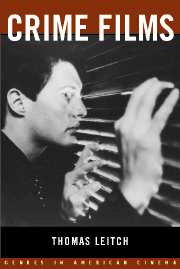Book contents
- Frontmatter
- Contents
- List of Illustrations
- Acknowledgments
- 1 The Problem of the Crime Film
- 2 Historical and Cultural Overview
- 3 Critical Overview
- 4 Fury and the Victim Film
- 5 The Godfather and the Gangster Film
- 6 Double Indemnity and the Film Noir
- 7 Basic Instinct and the Erotic Thriller
- 8 Murder on the Orient Express, Blue Velvet, and the Unofficial-Detective Film
- 9 Chinatown and the Private-Eye Film
- 10 Bullitt and the Police Film
- 11 Reversal of Fortune and the Lawyer Film
- 12 Fargo and the Crime Comedy
- 13 Conclusion: What Good Are Crime Films?
- Notes
- Selected Bibliography
- Filmography/Videography
- Index
6 - Double Indemnity and the Film Noir
Published online by Cambridge University Press: 27 October 2009
- Frontmatter
- Contents
- List of Illustrations
- Acknowledgments
- 1 The Problem of the Crime Film
- 2 Historical and Cultural Overview
- 3 Critical Overview
- 4 Fury and the Victim Film
- 5 The Godfather and the Gangster Film
- 6 Double Indemnity and the Film Noir
- 7 Basic Instinct and the Erotic Thriller
- 8 Murder on the Orient Express, Blue Velvet, and the Unofficial-Detective Film
- 9 Chinatown and the Private-Eye Film
- 10 Bullitt and the Police Film
- 11 Reversal of Fortune and the Lawyer Film
- 12 Fargo and the Crime Comedy
- 13 Conclusion: What Good Are Crime Films?
- Notes
- Selected Bibliography
- Filmography/Videography
- Index
Summary
The term film noir was first coined by French reviewer Nino Frank when the end of the wartime embargo brought five 1944 Hollywood films — The Woman in the Window, Laura, Phantom Lady, Double Indemnity, and Murder, My Sweet — to Paris in the same week in 1946. All five films seemed to take place in a world marked by menace, violence, and crime and yet distinct from the world of the gangster cycle of the 1930s. In christening the young genre, Frank was thinking not so much of earlier movies as of earlier novels. The label film noir was adapted from Marcel Duhamel's Série noire translations for Gallimard of British and American hard-boiled novels. The private-eye stories of Dashiell Hammett and of Raymond Chandler, whose gorgeously overwrought prose made him the most obvious stylistic patron of noir, had broken the decorum of the formal detective story from Conan Doyle to Agatha Christie. But an even closer analogue was to be found in the breathless suspense novels of James M. Cain (The Postman Always Rings Twice, 1934; Double Indemnity, 1936) and Cornell Woolrich (The Bride Wore Black, 1940; Phantom Lady, 1942), which trapped their heroes in a nightmarishly claustrophobic world of evil.
- Type
- Chapter
- Information
- Crime Films , pp. 126 - 145Publisher: Cambridge University PressPrint publication year: 2002

